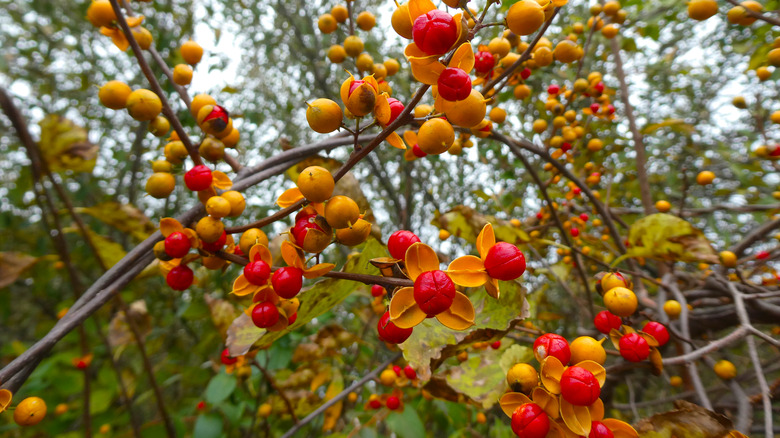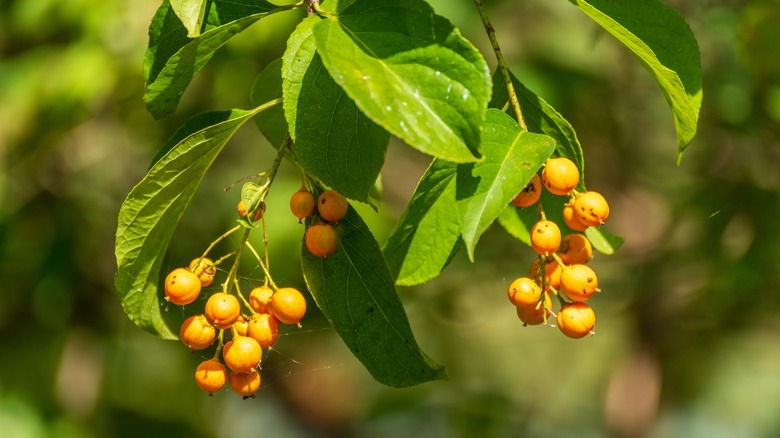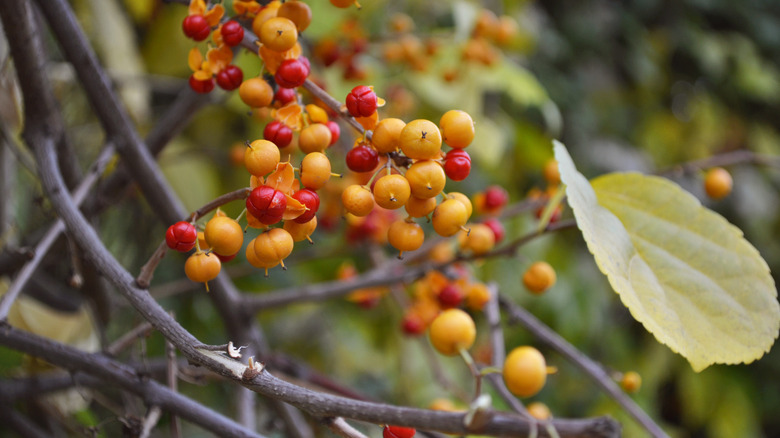The Aggressive Vine That Can Cause Severe Allergic Reactions (And How To Avoid It)
Gardening and landscaping can be pleasurable activities, but they're not without some inherent dangers. Poisonous insects and plants pose some risks, and it's good to be aware of when and where you might be exposed to them. One very common plant that causes many people an allergic reaction — in the form of an itchy, blistering rash — is poison ivy. But, another plant contains the same toxin as poison ivy, urushiol, and it can cause severe reactions in the people exposed to it: bittersweet.
Bittersweet is the common name given to the woody perennial vine Celastrus orbiculatus; it is also sometimes referred to as Oriental bittersweet, Chinese bittersweet, Asian bittersweet, or round-leaved bittersweet. It grows rounded green leaves that sometimes have a small point and produces red fruits covered in a bright yellow capsule in the fall. First brought to North America in the 1800s as an ornamental plant, the "berry"-covered vines are used to make wreaths. It is very similar to American bittersweet (Celastrus scandens L.), however, on this plant, the berries grow in clusters at the end of the vines. On Chinese bittersweet, berries grow all along the vine.
This plant is highly invasive: the woody vines can wrap around trees, fences, and other structures and grow up to 60 feet high. It is very difficult to eradicate once established and should be pulled out by the roots rather than cut (which will only stimulate deeper root growth).
How to avoid contact with bittersweet
It's difficult to avoid bittersweet if it grows in your yard or neighborhood. The oil in the plant that causes skin irritation, urushiol, is invisible, and it's impossible to know if you have it on you. Not everyone is sensitive to it, but once you develop a rash after contact, it is much more likely you will remain sensitive. So it's best to learn how to identify bittersweet to protect yourself and avoid contact with your skin to prevent a rash that may become serious. Treatment ranges from topical soaps and creams to oral steroids, depending upon the severity.
Urushiol can remain potent for weeks or even months on surfaces such as work gloves, clothing, or tools. It's also possible for your pet to get the oil on their fur, so try not to let your dog or cat have contact with it. If you're working near this plant, always wash up thoroughly with a degreasing soap (such as Dawn dish soap) afterward, and wash any clothes, gloves, or tools. The oil can also transfer to surfaces such as your car's steering wheel or seats, and remain there, so exercise caution if you're exposed.
It is crucial that you avoid burning bittersweet or poison ivy. The vines may resemble other woody brushes. But burning them creates smoke contaminated with the oil, and breathing it in can have serious consequences. Dispose of it immediately and away from other brushes.
How to get rid of bittersweet
Bittersweet grows in both wild and landscaped areas. If left to grow on trees, its parasitical nature allows it to spread out of control quickly. Entire orchards or groves of trees can be destroyed by bittersweet. Unfortunately, cutting it won't get rid of the problem and will likely cause it to grow more aggressively. But feel free to cut it back to control its habit as you prepare to use stronger measures.
The methods used to get rid of poison ivy can also work on bittersweet. If the vine hasn't spread too far, digging it up by the roots is best. The roots are a very bright orange or yellow, making them easy to locate and remove. However, if the weed has spread over a large area, try covering it with heavy black plastic for a year, depriving it of sunlight — this method is used with other invasive plants such as Japanese knotweed.
Other methods involve using horticultural vinegar, salt, or boiling water on the roots, especially if they're growing in sidewalk or foundation cracks. Let the plant sit for a few days after cutting to stimulate the root growth and thereby weaken the roots a bit. Then douse the root area with horticultural vinegar, very salty water, or boiling water. Finally, if none of these work, consider painting the exposed and cut roots with a toxic chemical herbicide, such as Roundup, but use plenty of care and caution.


